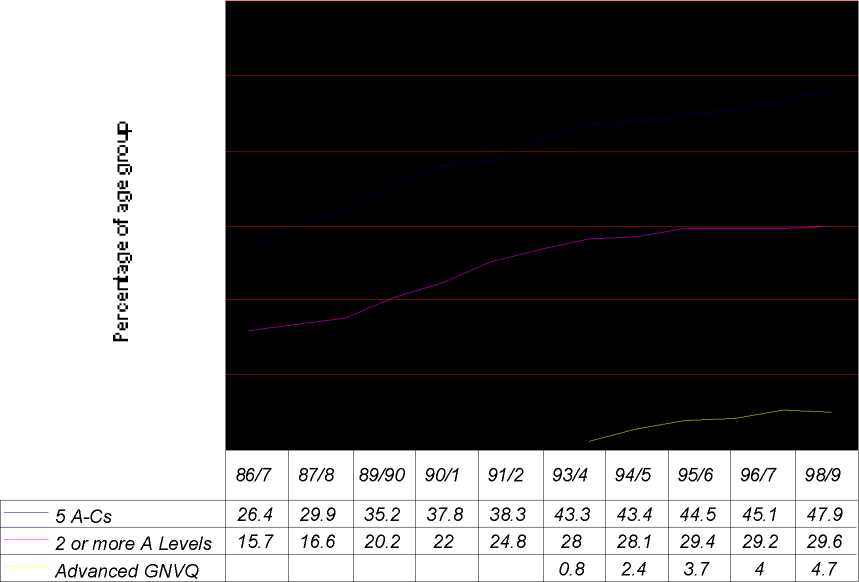The pattern of growth in qualifications attainment, which supports progression in the general
education route through to advanced level and higher education, broadly follows the pattern of
participation in full-time education. As Figure 2 demonstrates, attainment of five or more GCSE
A*-C grades has, in the mid to late 1990s, grown at under half of the annual rate by which it
increased in the late 1980s and early 1990s. This decelerating trend has been even more
pronounced at A Level, where there has not been any significant increase in the proportion of the
cohort achieving two or more A Levels over the last five years.
Figure 2: Proportion of cohort attaining 5 GCSEs A*-C grades, 2 or more A
Levels or an Advanced GNVQ

Source: DfEE (1999d) First Statistical Release SFR 35/1999 and DfEE Statistical Service
Attainment outputs from broad vocational advanced level qualifications have also failed to
increase over the recent period. While participation in Advanced GNVQ for 16-19 year olds has
grown steadily during the l990s (from five per cent to about 8.5 per cent of the cohort), its effect
on overall attainment levels has been compromised by very poor successful completion rates.
These have remained firmly depressed at 50 per cent during the mid-to-late 1990s, though by
1999 they had risen to 58 per cent (JCGAB 1999). Nevertheless, despite the recent improvement
in the effectiveness of the award, the overall impact of Advanced GNVQs on participation rates
in higher education remains limited. UCAS statistics on university applications suggest that
applicants holding Advanced GNVQ awards contribute about seven per cent annually to higher
education participation figures (UCAS 1999).
More intriguing information
1. Valuing Farm Financial Information2. Qualification-Mismatch and Long-Term Unemployment in a Growth-Matching Model
3. Rent-Seeking in Noxious Weed Regulations: Evidence from US States
4. Reversal of Fortune: Macroeconomic Policy, International Finance, and Banking in Japan
5. PROPOSED IMMIGRATION POLICY REFORM & FARM LABOR MARKET OUTCOMES
6. Feeling Good about Giving: The Benefits (and Costs) of Self-Interested Charitable Behavior
7. Demographic Features, Beliefs And Socio-Psychological Impact Of Acne Vulgaris Among Its Sufferers In Two Towns In Nigeria
8. How to do things without words: Infants, utterance-activity and distributed cognition.
9. The name is absent
10. The Institutional Determinants of Bilateral Trade Patterns